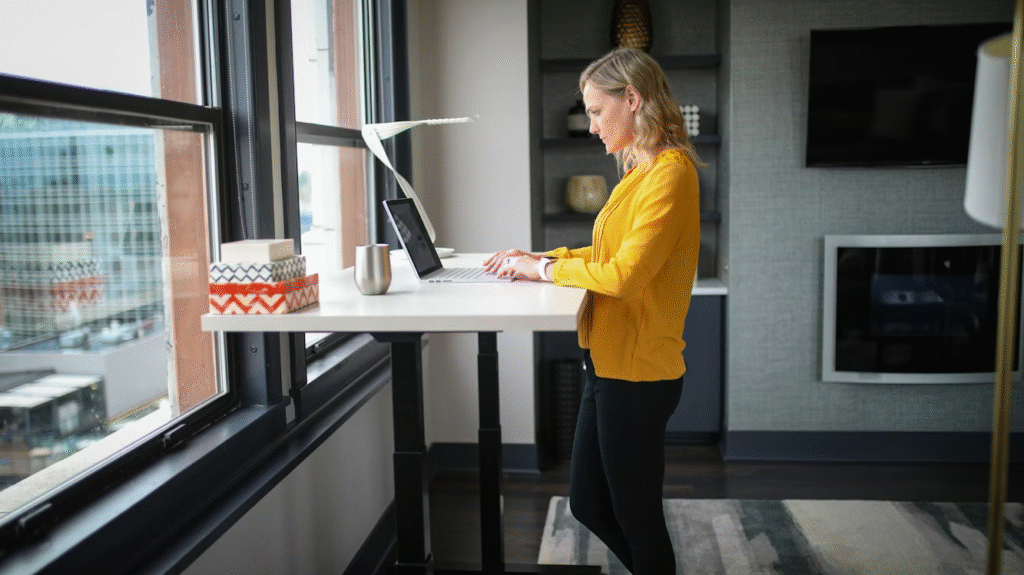Table of contents:
3. Pros and cons of standing desks
4. Proper ergonomics for standing desk
4.1 Desk and workstation setup
4.2 Body positioning and posture
5. Ergonomic assessment for standing desk
7. How long should you stand at a standing desk?
8. Optimising an ergonomic standing desk experience
Did you know that standing can increase energy expenditure by up to 10% compared to sitting?
Studies reveal that the sedentary lifestyle of sitting burns a mere 80 calories per hour, but there’s a game-changer: standing! When your employees embrace the ergonomics for standing workstations, their calorie burn skyrockets to an impressive 88 calories per hour.
As you continue to read, you’ll learn the pros and cons of standing desks, the proper ergonomics for a standing desk, and more.
What is a sit-stand desk?
A sit-stand desk, also known as an adjustable height desk or standing desk, is a type of desk that allows you to switch between sitting and upright positions while working. These desks are designed to promote a more dynamic and ergonomic workspace by providing the flexibility to adjust the desk to the correct height according to individual preferences.
A stand-up desk setup typically features a height-adjustable mechanism, allowing users to raise or lower the desktop surface to their desired level. This adaptability enables individuals to alternate between sitting and standing throughout the day, providing numerous benefits.

The correct ergonomics for a standing desk depend on each employee because everyone’s body is unique and may require individual adjustments. Factors such as height, arm length, and existing musculoskeletal conditions can vary from person to person, making it essential to customise the setup for optimal comfort and support.
Pros and cons of standing desks
“Is it better to sit or stand at work?” is a common question when considering the optimal posture for productivity and health in the workplace. If you’re thinking of having such desks in your employees’ workplace, you must know the standing desks’ pros and cons first.
The following are the pros of using standing desks:
- Increased calorie burn and improved blood circulation: Standing while working can help burn more calories and promote better blood flow throughout the body.
- Reduced risk of obesity and related health issues: Not sitting for long periods can contribute to weight management and lessen the risk of obesity, along with associated health conditions such as diabetes and heart disease. It helps combat the effects of sitting diseases.
- Enhanced energy levels and productivity: Standing can help combat sedentary behaviour, boost energy levels, and potentially improve focus and productivity.
- Potential for reduced back and neck pain: Properly set up desks can promote good posture and relieve pressure on the spine, potentially reducing back and neck pain.

- Improved posture and core strength: Standing engages core muscles and promotes better posture, leading to improved muscular strength and alignment.
Now it’s time to know the disadvantages of standing desks. Below are the cons of using it:
- Initial discomfort and fatigue: Transitioning to such a desk may initially cause discomfort and fatigue as your body adjusts to the new posture and increased activity.
- Risk of lower limb and foot problems: Prolonged standing can contribute to issues such as leg and foot fatigue, swelling, and discomfort if proper footwear and support are not used.
- Potential for varicose veins and swelling: Not sitting for prolonged periods can heighten the risk of developing varicose veins and swelling in the legs if precautions, such as regular movement and proper footwear, are not taken.
- Limited adjustment options for some standing desks: Using a standing desk has become increasingly popular in previous years due to its potential health benefits and ability to promote better posture and productivity. However, certain standing desks may have limited height adjustment options, which can make it challenging to find the perfect ergonomic setup for individuals of different heights.
- Difficulty with tasks requiring fine motor skills: Some tasks that require precise movements or fine motor skills, such as detailed mouse work or writing, may be more challenging to perform while standing compared to sitting.

- Too much standing work is harmful: While such desks have their benefits, excessive standing without breaks or proper posture can lead to fatigue, muscle soreness, and potential musculoskeletal issues.
Your employees must alternate between sitting and standing throughout the day and incorporate regular movement and breaks to avoid overstraining the body. They also need to observe the ergonomics of standing desks because improper positioning or prolonged standing can also cause health issues.
Proper ergonomics for standing desk
If your employees know how to use a standing desk properly, they can maintain optimal ergonomic alignment and promote comfort during prolonged standing.
Here’s a standing workstation ergonomics checklist that you can share with your employees.
Desk and workstation setup
- Adjustable desk height and appropriate positioning: Make sure your desk has adjustable height settings that allow you to position the desktop at a level that suits your height. To achieve the best way to stand, adjust the desk height so that your elbows are at a comfortable 90-degree angle when typing and your wrists are in a neutral position.
- Ample workspace and proper monitor height for standing desk: Ensure that your desk provides enough workspace to accommodate your computer, documents, and other essential items. The monitor should be directly in front of you at eye level to maintain a neutral neck position. Avoid straining your neck by tilting or angling the monitor appropriately.

- Ergonomic keyboard and mouse placement: Stand-up desk ergonomics involves placing your keyboard and mouse on a stable surface at a height that allows your arms to rest comfortably at your sides. Your wrists should remain straight, and your shoulders relaxed. Consider using an ergonomic keyboard and mouse that provide additional support and promote proper hand and wrist alignment.
- Adequate lighting and reduction of glare: Ensure that your desk area is well-lit to minimise eye strain. An ergonomic standing desk setup uses additional lighting sources to eliminate shadows and reduce glare on your computer screen. Adjusting the contrast and brightness settings on your monitor can also help reduce eye fatigue. To explore more about illumination, read our blog about the ergonomics of lighting.
Body positioning and posture
- Neutral spine alignment and avoiding excessive leaning: Stand tall with your shoulders relaxed and your spine in a neutral position. Avoid excessive leaning forward or backwards, as it can strain your back and neck. To maintain an ergonomic position for a standing desk, engage your core muscles to support your spine and maintain stability.
- Balanced weight distribution on both feet: Distribute your body weight evenly between both feet. Avoid leaning to one side or putting excessive pressure on a single foot, as it can lead to muscle imbalances and discomfort. Consider using an anti-fatigue mat to provide cushioning and support for your feet.
- Slight knee flexion and avoiding locking knees: Keep a slight bend in your knees instead of locking them. This helps to reduce strain on the joints and promotes better blood circulation. Avoid prolonged static positions and shift your weight or take short breaks to relieve any pressure on your knees.

- Proper arm and wrist positioning: Sit-stand desk ergonomics involves positioning your arms comfortably at your sides with your elbows bent at approximately 90 degrees. Avoid raising or dropping your shoulders and keep them relaxed. Your wrists should be in a neutral, straight position while typing or using a mouse. Consider using wrist supports or ergonomic accessories if needed.
Movement and breaks
- Regular changes in posture and frequent movement: Avoid prolonged static standing by making regular changes in your posture. Shift your weight from one foot to the other, alternate between standing and sitting if your desk allows, or take short walks during breaks. These movements help prevent muscle fatigue and promote blood circulation throughout your body.
- Incorporation of stretching and standing breaks: Take advantage of breaks to incorporate stretching exercises that target the muscles that tend to get tense or fatigued while standing. Stretching your legs, hips, and back can help alleviate any stiffness and improve flexibility. Additionally, consider taking short breaks throughout the day to give your body a rest from prolonged standing.

- Use of anti-fatigue mats or supportive footwear: Standing on hard surfaces for prolonged periods can cause foot and leg discomfort. Consider using an anti-fatigue mat under your desk to provide cushioning and support for your feet. Additionally, wearing supportive and comfortable footwear with proper arch support can help lessen the strain on your feet and provide added comfort.
Implementing these proper ergonomics guidelines for a standing desk is crucial for maximising comfort, productivity, and overall well-being. By following these tips for standing desk setup, you can create an ergonomic workspace that supports your body and promotes a healthy work environment.
Your employees must maintain correct posture for standing desks because it plays a vital role in preventing musculoskeletal issues and promoting long-term health and productivity. Consider knowing more about an ergonomic assessment. If you’re ready for a virtual ergonomic assessment which is client-specific and fully customisable, book an evaluation with our Individual Virtual Ergonomic Assessment today!
Ergonomic assessment for standing desk
It is crucial to focus on the setup of the ergonomic workstation of standing. You must be concerned not only about how to properly stand at a standing desk but also about the workstation itself. Here’s a concise set of essential considerations for an office ergonomics standing desk.
Workstation setup
- Ensure the desk has adjustable height settings to accommodate different employee heights.
- Position the desk at a height that allows for a 90-degree angle at the elbows when typing.

- Provide ample workspace to accommodate the computer, documents, and other essential items.
- Position the monitor directly in front of the employee at eye level to maintain a neutral neck position.
- Consider using additional accessories like cable management systems or ergonomic keyboard trays.
Monitor position
- Place the monitor at eye level to avoid straining the neck and promote a neutral posture.
- Ensure the monitor is directly in front of the employee, preventing excessive neck or eye movement.
- Adjust the monitor’s brightness, contrast, and viewing distance for optimal visibility and reduced eye strain.
Standing desk posture
- Maintain a neutral spine alignment by standing tall with shoulders relaxed.
- Avoid excessive leaning forward or backwards, which can strain the back and neck.
- Engage the core muscles to support the spine and promote stability.
- Keep the elbows bent at approximately 90 degrees, with wrists in a neutral position.
- Avoid raising or dropping the shoulders and keep them relaxed.
Foot and leg position
- Distribute body weight evenly on both feet to prevent strain or imbalances.
- Keep a slight bend in the knees rather than locking them, promoting better blood circulation.
- Utilise anti-fatigue mats to provide cushioning and support for the feet.
- Encourage employees to wear supportive footwear with proper arch support.
By following the checklist for each aspect of stand-up computer workstation ergonomics, employees can ensure they have a well-set-up workstation, maintain proper posture, and incorporate movement and breaks to support their overall well-being and productivity.
Standing desk office setup

Choosing the right standing desk and accessories
Selecting a standing desk that suits your employees’ needs and preferences is essential for a successful office setup. Consider factors such as desk height adjustability, stability, and durability.
Additionally, choose ergonomic accessories like an adjustable monitor stand, an ergonomic keyboard, and a supportive chair to enhance comfort and productivity.
Organising cables and ensuring a clutter-free workspace
Keeping cables neat and organised is crucial for both aesthetics and functionality. Use cable management solutions such as cable clips, cable sleeves, or cable trays to keep cords untangled and out of the way. A clutter-free workspace promotes better focus and reduces the risk of tripping hazards.
Incorporating storage solutions for easy access to essentials
Efficient storage solutions are vital for maintaining an organised and efficient standing desk office setup that adheres to ergonomic standards. Consider incorporating shelves, drawers, or bins to keep frequently used items within reach. Having a designated space for documents, stationery, and other essentials enhances productivity and minimises distractions.
Considering lighting, acoustics, and other environmental factors
Pay attention to the lighting and acoustics of your workspace. Ensure adequate and well-positioned lighting to reduce eye strain and shadows in your work area. Consider using task lighting or adjustable desk lamps for additional flexibility. Additionally, address any noise-related issues by using sound-absorbing materials or implementing white noise machines to create a more peaceful and productive environment.
How long should you stand at a standing desk?

Experts have been recommending that individuals stand at their workstations for approximately 15 minutes per hour, as sitting for prolonged periods is known to have negative health effects. However, recent research conducted suggests that in order to reap health benefits, people should aim to stand for at least 30 minutes per hour.
Again, while standing at a desk can have health benefits, it is important to consider the ergonomic height of a standing desk to maximise its effectiveness. Standing for extended periods at an incorrect height can lead to discomfort and strain on the body. It is crucial to adjust the standing desk to an ergonomic height that suits your individual needs.
Optimising an ergonomic standing desk experience
The ergonomics of a standing desk involve adjusting the desk and workstation setup to promote proper posture, considering the height of the desk, positioning of the monitor, and placement of the keyboard and mouse. It is essential to keep a neutral spine alignment, distribute body weight evenly, and incorporate movement and breaks to prevent fatigue. Additionally, considering environmental factors and utilising supportive accessories like anti-fatigue mats contribute to a comfortable and productive standing desk experience. Prioritising ergonomic principles ensures a healthier and more efficient workspace.
When you observe the ergonomic use of standing desks, you can create a more comfortable and productive work environment. When employees are properly supported and encouraged to maintain good posture, they are less likely to experience discomfort or musculoskeletal issues, leading to reduced absenteeism and improved overall well-being.
Don’t wait too long until you recognise the ergonomic risk your employees are facing. Our Ergonomic Risk Management helps solve problems before they arise. Book a consultation now!



